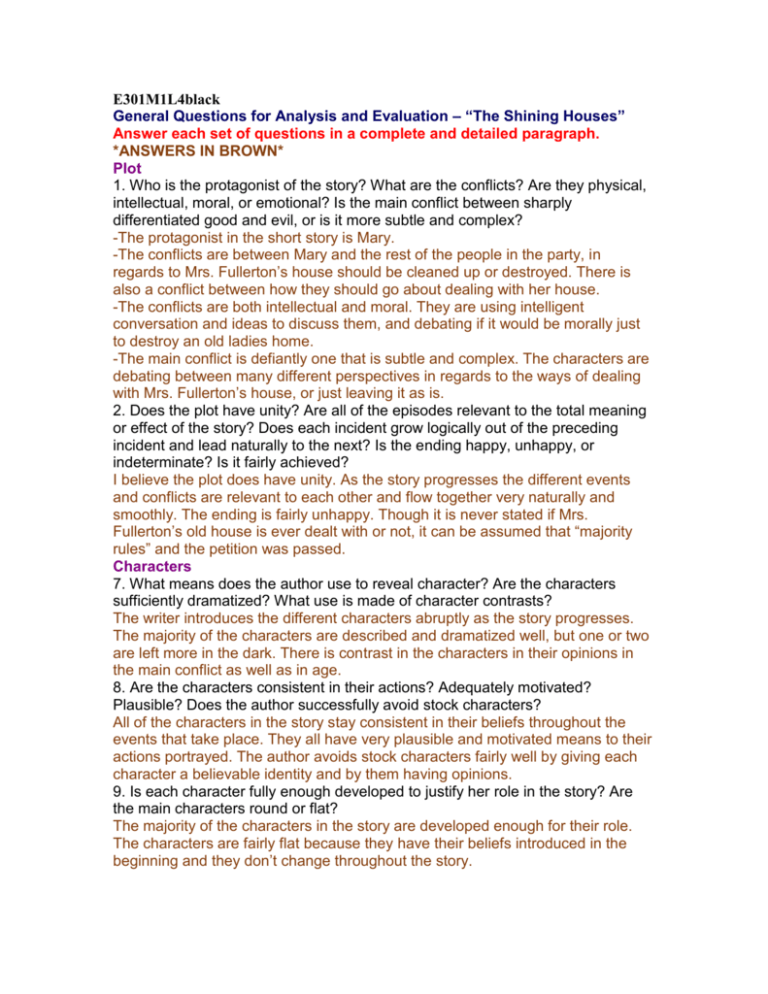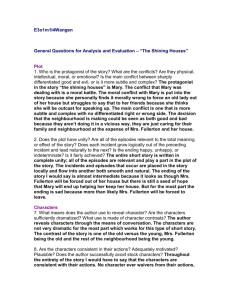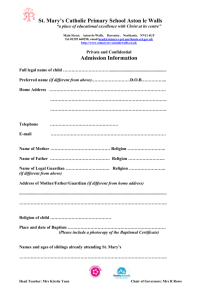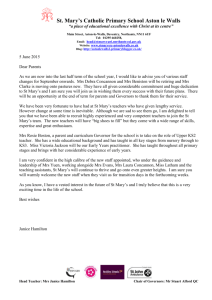E301M1L4black.doc
advertisement

E301M1L4black General Questions for Analysis and Evaluation – “The Shining Houses” Answer each set of questions in a complete and detailed paragraph. *ANSWERS IN BROWN* Plot 1. Who is the protagonist of the story? What are the conflicts? Are they physical, intellectual, moral, or emotional? Is the main conflict between sharply differentiated good and evil, or is it more subtle and complex? -The protagonist in the short story is Mary. -The conflicts are between Mary and the rest of the people in the party, in regards to Mrs. Fullerton’s house should be cleaned up or destroyed. There is also a conflict between how they should go about dealing with her house. -The conflicts are both intellectual and moral. They are using intelligent conversation and ideas to discuss them, and debating if it would be morally just to destroy an old ladies home. -The main conflict is defiantly one that is subtle and complex. The characters are debating between many different perspectives in regards to the ways of dealing with Mrs. Fullerton’s house, or just leaving it as is. 2. Does the plot have unity? Are all of the episodes relevant to the total meaning or effect of the story? Does each incident grow logically out of the preceding incident and lead naturally to the next? Is the ending happy, unhappy, or indeterminate? Is it fairly achieved? I believe the plot does have unity. As the story progresses the different events and conflicts are relevant to each other and flow together very naturally and smoothly. The ending is fairly unhappy. Though it is never stated if Mrs. Fullerton’s old house is ever dealt with or not, it can be assumed that “majority rules” and the petition was passed. Characters 7. What means does the author use to reveal character? Are the characters sufficiently dramatized? What use is made of character contrasts? The writer introduces the different characters abruptly as the story progresses. The majority of the characters are described and dramatized well, but one or two are left more in the dark. There is contrast in the characters in their opinions in the main conflict as well as in age. 8. Are the characters consistent in their actions? Adequately motivated? Plausible? Does the author successfully avoid stock characters? All of the characters in the story stay consistent in their beliefs throughout the events that take place. They all have very plausible and motivated means to their actions portrayed. The author avoids stock characters fairly well by giving each character a believable identity and by them having opinions. 9. Is each character fully enough developed to justify her role in the story? Are the main characters round or flat? The majority of the characters in the story are developed enough for their role. The characters are fairly flat because they have their beliefs introduced in the beginning and they don’t change throughout the story. 10. Is any of the characters a developing character? If so, is the change a large or a small one? Is it a plausible change for her? Is it sufficiently motivated? Is it given sufficient time? Mary is a developing character. She undergoes a small change in realizing that she has lost the battle for Mrs. Fullerton’s house. Her change in belief is plausible in such short time given how her change is fairly minor. Theme 11. What is the theme of the story? Is it implicit or explicit? The story has an explicit theme being the impact that certain things can have on its surrounding area, and that no matter how many people believe one thing, there will always be someone who has another point of view. 12. Does the theme reinforce or oppose popular notions of life? Does it furnish a new insight or refresh or deepen an old one? The theme reinforces the notion of different people’s ideas of beauty. As well as each individual having their own opinion and it being human nature to argue and express them. Point of View 13. What point of view does the story use? Is it consistent in its use of this point of view? If shifts are made, are they justified? The story uses Mary’s point of view in an effort to have the reader sympathize with her. The point of view stays consistent while allowing the other characters points of view still be expressed. 14. What advantages has the chosen point of view? Does it furnish any clues as to the purpose of the story? The advantage of using Mary’s point of view is to have the reader agree with her side over the others. It gives the reader the sense of her being the protagonist. 15. If the point of view is that of one of the characters, does this character have any limitations which affect his interpretation of events or persons? By using Mary’s point of view it limits the reader to who they side with. Though they still have an option they are greatly persuaded to take Mary’s side. Symbol and Irony 17. Does the story make use of symbols? If so, do the symbols carry or merely reinforce the meaning of the story? The story uses symbols of an old, self-sufficient house to help reinforce the meaning. General 26. What light is thrown on the story by its title? A light that the surrounding houses shine brighter and are more important than the smaller, older one of Mrs. Fullerton. NOTE: The document I opened only had these question numbers. I was unsure if questions were missing or not. If there are questions lost somewhere is cyberspace please let me know! Thanks Trevor







